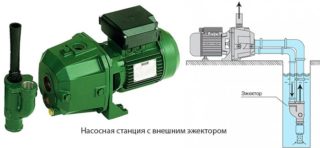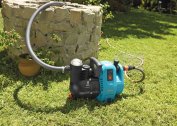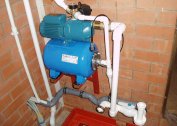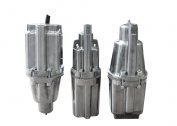Autonomous water supply in suburban areas is a modern approach to providing water to facilities located away from centralized networks. The water main is based on a pump. Three of its varieties are used: deep, submersible and superficial. Most often use the latter, because it is convenient to use. But such a pumping unit has a small water intake depth. To increase this technical characteristic, an additional element is used - an ejector. It can be mounted in a pumping station, or it can be a separate unit - remote.
How is the ejector arranged
 The basis of the principle of operation is the physical law of increasing the speed of the water flow due to the flow itself. This law bears the name of its creator - physicist Bernoulli. The ejector consists of four parts:
The basis of the principle of operation is the physical law of increasing the speed of the water flow due to the flow itself. This law bears the name of its creator - physicist Bernoulli. The ejector consists of four parts:
- the suction compartment, it's the same chamber;
- mixing compartment;
- reduced diameter nozzle;
- diffuser.
Water moving with great speed inside the pipe creates a vacuum around itself. Due to this, an additional speed is given to the water flow. To create a vacuum, a high water speed is required. It is created by a pumping station.
The ejector is connected to the pump by two pipes or nozzles. The pump simply draws water through the first pipe. Then, through the second pipe, he returns part of the liquid back to the ejector. This water passes under pressure through a nozzle with a reduced hole, where its speed increases several times.
 The principles of operation of pumping stations with a remote ejector and built-in are the same. In the first case, the accelerator device itself is installed inside the well or well, and is recessed into the water mass. In the second, it is located inside the pumping station and is its integral part.
The principles of operation of pumping stations with a remote ejector and built-in are the same. In the first case, the accelerator device itself is installed inside the well or well, and is recessed into the water mass. In the second, it is located inside the pumping station and is its integral part.
In this case, in the first case, the pump with the ejector is connected by two pipes, which increases the consumption of materials, but not by much. In the second, only one pipe is lowered from the pump station to the source of water intake.
The ejector has another serious plus. It works as a separate item. For a short time, he can independently pump water. This protects the pumping stations from dry running.
In order to regulate the volume of recirculated water flow, as well as its speed, a regular tap is installed on the return pipe circuit. With partial closure, the volume and speed decrease, the efficiency of the device and the depth of water intake decrease.
Built-in or external
The location of the device affects the installation of the pump and its efficiency.
With pumping stations with a built-in ejector it is easier. Their installation is simple and economical. The device itself is located on the surface, which means it is easier to control, maintain and repair. It takes up little space, so it does not bother anyone. The device is installed in the station building, therefore it is well protected from pollution. There is no need to additionally install filters to protect it from sand, silt and small stones.
However, this arrangement does not provide maximum technical and operational characteristics. Pumps with a built-in ejector can lift water from a depth of 10 m. Maybe even lower, but then the pressure and productivity of the station decreases.
Another minus is the noise from a working installation. Sounds of moving water inside the ejector are added to the noise of the pump. They are not strong, but are well captured by the human ear. Therefore, when installing a pump station with a built-in ejector, you should consider the sound insulation system. For example, install a cap over the equipment, mount it in the utility room or in the caisson, but not inside the house.
Remote models in terms of material consumption and installation are more complicated.But other pluses cover minor flaws.
- The pump can lift water from a depth of 40 m.
- Noise is heard from the ejector.
If you compare the two varieties in terms of overall performance, the built-in is better. Given the depth of water intake, preference should be given to an external model. Since water located at great depths is cleaner, it is recommended to purchase pumping stations with built-in accelerators.
Features and rules for connecting pumping stations
Equipment with a built-in ejector is connected to an autonomous water supply network as standard. A pipe is connected to the suction pipe, which is lowered into a water supply source. To the outlet pipe - the pipe going into the house.
Installation of a pumping station with a remote ejector is carried out according to a more complex scheme. The entire assembly is carried out on the surface, and then the finished unit with pipes is lowered into the well or well.
- The suction port of the ejector is connected to a small nozzle into which the check valve is pre-cut, and a strainer is installed at the bottom.
- On the opposite side to the outlet connect a pipe (hose), through which water will rise to the pump station.
- Another pipe is connected to the second hole (recirculation).
- An ejector with pipes is lowered into a hydraulic structure.
Both pipes are connected to pumping equipment. The first to the suction pipe, the second to the tee, which divides the water flow into two circuits: inside the house, down to the ejector. On the last circuit, near the tee, a crane must be installed, with which it will be possible to adjust the speed of water movement.
The control valve works like this: the more it is closed, the more water will flow into the domestic water supply. If the load on the water supply network has increased, then you can open the tap more by driving water down to the ejector. Ejectors with an automatic adjustment system appeared on the market. Using them, you can refuse to install a crane.
In the process of installing a remote ejector, the main thing is not to confuse the pipes, more precisely, their connection to the pump station. One of them is somehow celebrated. For example, the external end that will be connected to the pump is painted or wound with electrical tape.
The appearance of an ejector has solved many problems. No need to purchase expensive submersible pumps. There was an opportunity to use surface installations for water intake from wells. But we must take into account the fact that pumping stations are not self-priming equipment. Therefore, before starting work, they must be filled with water through a special hole in the housing.



